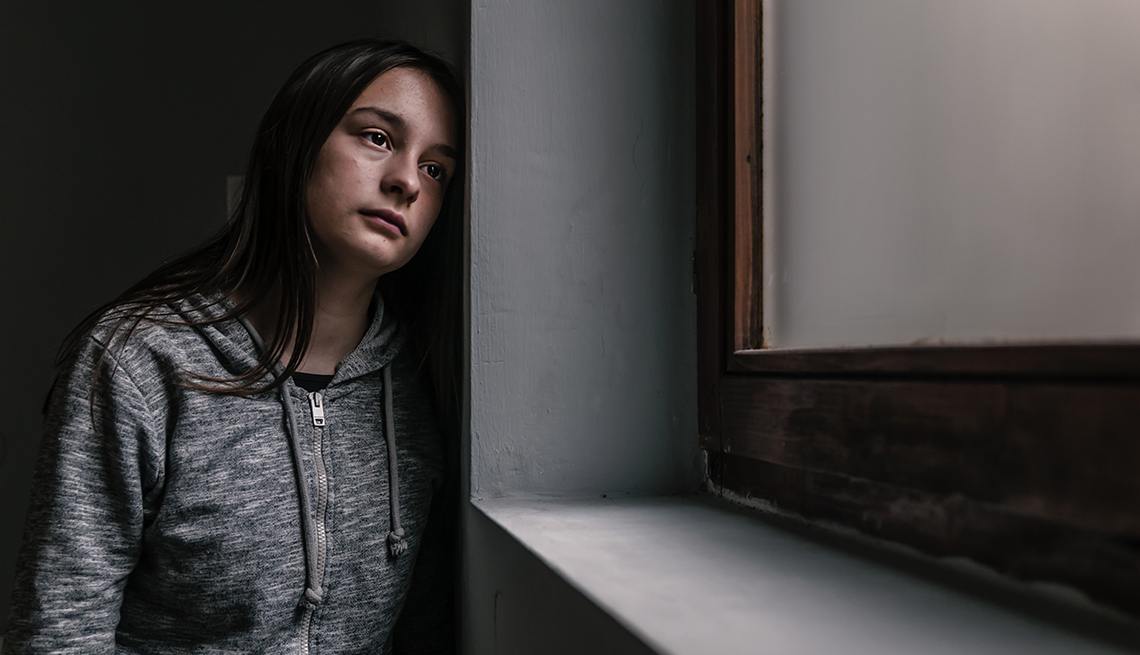AARP Hearing Center
Something has happened to my daughter. I am terrified. I am alone. I am exhausted. It is my responsibility to keep her safe and happy and I am failing as her mom. For weeks, my once vibrant, beautiful girl, with long ginger hair, blue eyes, who always took pride in how she looks, has retreated to her bed. Her hair is matted and heavy from not washing it in days. The air in her room is stagnant. It is pitch black with the shades drawn. She is not eating. She is sleeping all the time. She isn’t seeing friends and she isn’t going to school. She lashes out at me or stares at me blankly when I try and engage her. I miss her laugh. I miss the sound of her voice. This isn’t my girl. My girl, who used to blast music, sing loudly, FaceTime friends around the clock, and find a reason to live joyfully is barely living.
These are the words of Tanya Trevett, a Boston-based former special education teacher and single mom of three teen girls. Trevett’s oldest daughter, Emma, 17, has anxiety, depression and bipolar disorder. In her journal, Trevett traced Emma’s “journey” from being an outgoing girl whose report card was a string of straight A’s and whose afternoons were spent playing soccer, to a teenager who could barely function — a girl she barely recognized.
A troubling trend
Unfortunately, Trevett’s experience is hardly uncommon. The country is in the midst of what U.S. Surgeon General Vivek Murthy, M.D., recently warned is a growing mental health crisis among young people. Troubling numbers confirm his fears. In March, the Centers for Disease Control and Prevention (CDC) revealed that more than four in 10 teens reported feeling “persistently sad or hopeless” in 2021. It was the latest in a string of troubling statistics. The CDC also found that suicide rates for young people ages 10 to 24, which had been stable from 2000 to 2007, jumped nearly 60 percent by 2018. And suicide is now the second leading cause of death for college students.
Some young people are more at risk than others. A government survey of almost 8,000 high school students, conducted in the first six months of 2021, found that the rate of major depressive episodes was higher among adolescent girls (25.2 percent) compared to boys (9.2 percent). Between 1991 and 2017, suicide attempts by Black adolescents rose a whopping 73 percent, compared with a 7.5 percent decrease among white adolescents. But the uptick in depression and suicide spans every demographic — no ethnic group, social class, race or gender identity has been immune to it.
What’s behind the crisis?
Technology
The COVID-19 pandemic has fueled the crisis, to be sure, experts say: It’s disrupted core developmental experiences, such as senior year, graduation and the transition to college. “The social component has been especially brutal,” says Lucas Zullo, a clinical psychologist at the UCLA Youth Stress and Mood Program. People are less at risk for depression if they are “able to link to friends, family, and have those strong, supportive interactions,” he notes. “That was all taken away when we were in full lockdown.”
But the CDC has found that rates of depression, anxiety and suicide in adolescents and young adults were on the rise before COVID-19. Zullo and other mental health professionals believe the pandemic merely accelerated and accentuated them.
They point to other powerful influences on young people’s mental well-being, such as technology. On the one hand, social media is a great way to stay connected, says Laurence Steinberg, a professor of psychology at Temple University and an expert on adolescence. “But we also know [that] for some kids, social media has an adverse effect on their mental health. It’s a minority of kids, but it happens to be the kids who are the most vulnerable. When the popular one goes online, she sees a lot of terrific things about herself. She gets a lot of compliments from her friends. She gets a lot of likes and communication about shared interests. The unpopular one goes online and she’s going to feel excluded, and she’s not liked. In some ways, the rich get richer and the poor get poorer.”
However, the impact of social media on kids’ mental health may not be entirely about the experience of using it, but what that activity is displacing. “We know that depression is correlated to a lack of sufficient sleep and with a lack of sufficient exercise,” says Steinberg. “If social media is stopping kids from engaging in activities that are good for them, it is contributing to poor mental health.”
Unrelenting bad news
And then there’s the news: a potent cocktail of political divisiveness, school shootings, an uncertain economy, climate change and a war in Ukraine. The hits seem to keep coming. “We have access to this information, but we’re not good at disconnecting from it,” says Shannon Bennett, clinical site director for the New York-Presbyterian Youth Anxiety Center. “That keeps us constantly tied to the things that make us most afraid.”





































































